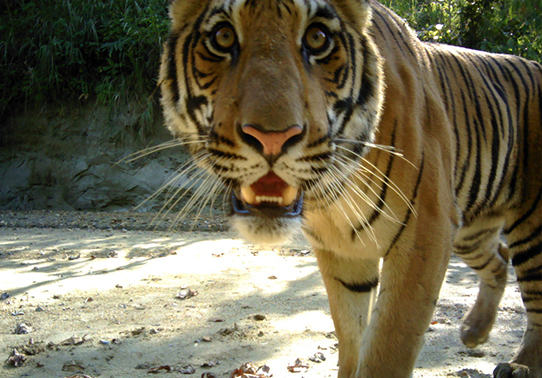The tiger is the only big cat species to be classified as Endangered by the IUCN. Additionally, three of its subspecies (the Malayan, Indochinese and Sumatran tigers) are classified as Critically Endangered. Tigers are at the focal point of Panthera’s struggle to save Endangered species from the brink. Decades of rampant poaching, habitat loss and human-cat conflict have decimated the wild tiger population — estimated at 4,500 in the Panthera-led 2022 IUCN Red List Assessment for Threatened Species. Although this figure suggests the population is stabilizing or even increasing in parts of the species range, our collective work to protect tigers is more urgently needed now than ever before. Panthera’s Tigers Forever program operates at key sites across Asia to increase tiger numbers by at least 50 percent over a 10-year period.
History
Although several tiger conservation efforts existed before Panthera’s Tigers Forever Program was born, they were too diffused to make an impact at a range-wide scale. To reverse the catastrophic tiger decline, Panthera concluded that we needed a razor-sharp focus on the most critical threats to tigers in key sites — and that’s exactly what we did. In 2011, we merged with Save the Tiger Fund, which supported hundreds of wild tiger conservation projects across tiger range states in Asia. This partnership combines decades of experience and success in identifying conservation priorities, using best practices and implementing proven strategies to address the many challenges that wild tigers face.
Our Approach to Protecting Tigers
Today, our Tigers Forever Program employs a suite of complementary activities to secure and recover tiger populations. In critical sites across five tiger range countries (India, Indonesia, Malaysia, Nepal and Thailand) Panthera and partners monitor populations of tigers and their prey, support counter-poaching efforts to secure protected areas, and connect and protect tiger habitats.
Together with governments and local NGOs, we address the most urgent threats facing tigers: poaching, habitat loss and human-cat conflict. Our approach includes:
- Identifying, protecting and connecting key tiger habitats and corridors;
- Building the capacity of rangers, support staff, wildlife crime analysts, prosecutors and judges to combat illegal poaching through our recently launched Counter-Wildlife Crime Program;
- Utilizing and contributing to the development of conservation technology tools such as SMART and PoacherCams to enhance our understanding of poaching patterns to inform our crime prevention strategies;
- Working with local communities to reduce human-tiger conflict and improve livelihoods while reducing dependency on tiger habitats; and
- Monitoring tiger populations and offering training on best practices to measure impact and success.
Our Impact on Tigers
Our conservation initiative is paying off in real and tangible ways. Six of our seven project sites show evidence of stable or increasing populations and high survival rates for individual tigers. In Thailand’s southern Western Forest Complex (sWEFCOM), we have witnessed the tiger population nearly double over the past decade at some sites and we are continually expanding protected areas that provide safe passage for dispersing tigers. With partners, we have also helped more than triple the number of tigers detected in Manas National Park, India, a former conflict area where the tiger population was nearly poached to local extinction. Our work in Kenyir, Taman Negara, Malaysia has helped avert the local extinction of the Critically Endangered Malayan tiger.
We’ve conducted workshops across the globe, training citizens, officials and rangers alike. In total, we’ve trained over 600 rangers, judges, support staff, problem analysts and prosecutors. With partners by our side, a collaborative process to protect tigers is mobilizing like never before. And in 2020, we stepped up our efforts by establishing offices in Thailand and Malaysia.
We continue developing our expertise in deep forest counter-poaching and wildlife crime problem-solving in order to keep one step ahead of sophisticated poachers. We work in collaboration with local authorities, such as the Department of Wildlife and National Parks Malaysia, Terengganu State Government, as well as other allies such as Nature Based Solutions, Justice for Wildlife Malaysia, and other NGOs. More recently, our Malaysian team have started working closely with the Pahang State Government to support the Save The Malayan Tiger Campaign led by HRH Tengku Hassanal Ibrahim Alam Shah, in the formation of a new protected area for tigers and to develop an elite team of community rangers from indigenous and local Malay communities of Hulu Tembeling, to support the newly established Pahang State Parks Corporation in safeguarding tigers and their prey.
Partnering to Protect Tigers in Malaysia
Project Kenyir is a conservation initiative led by Panthera Malaysia in collaboration with the Department of Wildlife and National Parks. It focuses on protecting and monitoring the Malayan tiger and other wild cat species within the Kenyir-Taman Negara Core Area, located in the northeast section of Taman Negara National Park in Terengganu, Malaysia. This region, part of one of the world's oldest rainforests, is home to seven wild cat species, making it a critical area for biodiversity. The project's efforts include counter-poaching operations and habitat preservation to ensure the survival of these species.
Top Three Ways to Help Protect Tigers
Donate to Panthera
Making a donation of any size will further Panthera’s efforts to protect tigers and other wild cats from today’s most urgent threats.
Learn more about the issues facing tigers
Read about the illegal wildlife trade, biodiversity loss and poaching. But don’t stop there — sign up for Panthera’s emails to get the latest updates on wild cat conservation.
Support legislation that protects wildlife and spread awareness
Wherever you live, vote for government representatives and legislation that protect endangered species. You can also help spread awareness about Panthera by promoting posts by @pantheracats on social media.
Notable Scientific Publications
- IUCN Red List Assessment of Threatened Species: Tigers
- Tigers At a Crossroads: Shedding Light on the Role of Bangladesh in the Illegal Trade of This Iconic Big Cat
- Setting Recovery Targets for a Charismatic Species in an Iconic Protected Area Complex: The Case of Tigers (Panthera Tigris) in Chitwan–parsa National Parks, Nepal
- Learning From Perpetrator Replacement To Remove Crime Opportunities and Prevent Poaching of The Sundarbans Tiger
- Demographic and Ecological Correlates of a Recovering Tiger (Panthera Tigris) Population: Lessons Learnt From 13-years of Monitoring




